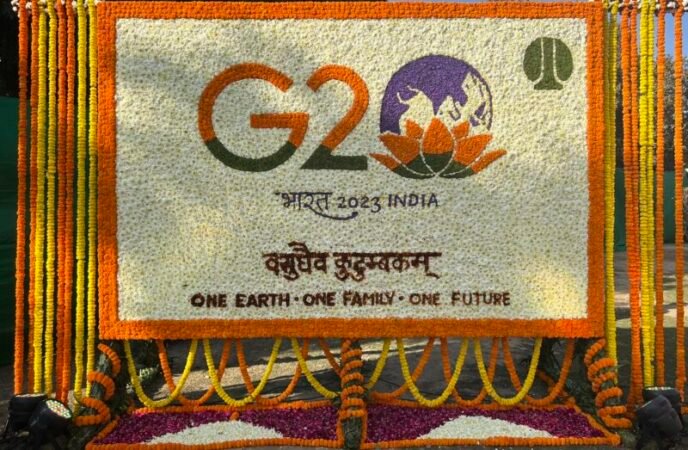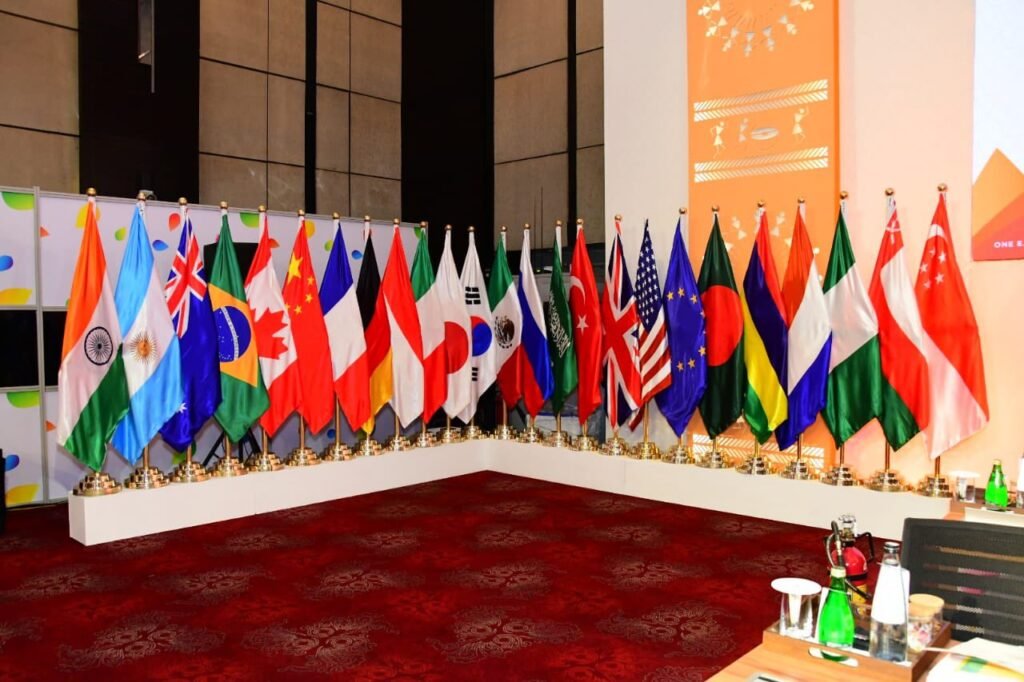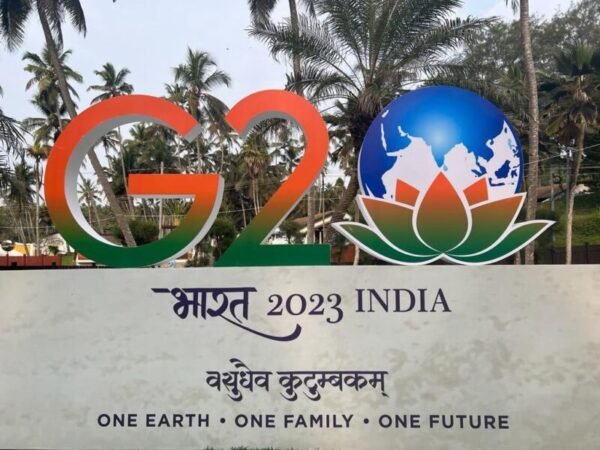Global Scenario and India’s Presidency in G20

On 30th January 2023, India’s first Model G20 summit was organized by the Indian Institute of Democratic Leadership at the Rambhau Mhalgi Prabodhini’s Uttan campus near Mumbai to celebrate India’s presidency and take the vision of G20 to the youth, which was officially inaugurated by Mr Amitabh Kant (CEO of NITI Aayog). He said that the post-COVID issues are the geopolitical crisis, the debt-trap issues, the climate, and the food and energy crises that came when India assumed G20 leadership.[i] However, meeting held on December 4, 2022, i.e. the first Sherpa Meeting of India’s G20 Presidency at Udaipur, Rajasthan in which several global difficulties were highlighted. One of the speakers pointed out that India will promote a feeling of oneness for all people and work with other countries to find answers. India’s position as a spokesperson for the ‘Global South’ was also emphasized.[ii] In both meetings, one thing was common, i.e., the global crisis, which covers the geopolitical, debt, climate, and food and energy crises. In the meanwhile, that article has analyzed why the global energy crisis occurred and how India will tackle it through its agenda program of the G20 presidency.
Background
Indeed, the formation of G20 aims to cooperate and save the world from any major financial crisis like 1997 and 2008. It is an intergovernmental fora with 19 countries and the European Union. Annually, the G20 Summit is conducted with a rotating Presidency. It will be led by India from December 1, 2022, until November 30, 2023. The final New Delhi Summit will take place in September. For one year, the G20 Presidency sets the agenda and hosts the Summit. India will hold over 200 sessions across 32 distinct work streams over cities. For India, the G20 Presidency also heralds the start of “Amritkaal,”. The 25 years started from the 75th anniversary of its independence on August 15 2022, and ended with the centennial of its sovereignty and aimed at creating a future-oriented, prosperous, inclusive, and developed society characterized by a human-centric approach at its core.[iii]

Aim of Indian policymakers
Indian policymakers targeted two things while setting the agenda for G20 one is India’s long-term vision of ‘Amritkaal’, and the second is to safeguard the interest of ‘Global South‘. Under the theme of ‘Vasudhaiva Kutumbakam’, which means “One Earth, One Family, One Future,” India classified its agenda for G20s are –
- Green Development, Climate Finance & Lifestyle for Environment (Life);
- Accelerated, Inclusive & Resilient Growth;
- Accelerating progress on Sustainable Development Goals (SDGs);
- Technological Transformation & Digital Public Infrastructure
- Multilateral Institutions for the 21st century;
- Women-led development”[iv]
Theoretical Perspective
However, to understand the global energy crisis mentioned in the Model summit and Sherpa summit of G20, one needs to move out of the mainstream school of international relations, i.e., realism and liberalism, and to understand through the lens of a constructive approach. The study of international relations should concentrate on tangible elements that influence state security in terms of border security and energy security. This method of mainstream theories ignored the ideational factors affecting nation-states’ operations. Therefore it is necessary to study the alternative view on the behaviour of the global hegemon, i.e. the United States (USA) and how emerging economies of G20 under India’s Presidency are working to tackle it.
Policies of Global Hegemon and its impact
The contemporary global scenario is very challenging for the emerging economies of G20, especially for India, as the geopolitical policies of the USA like the Countering America’s Adversaries Through Sanctions Act (CAATSA)’, impose unilateral sanctions against Iran, Russia and North Korea.[v] Among them, Iran and Russia are energy-rich countries. India is a net importer of oil and gases. It also has very bonhomie relation with both the energy exporter. Moreover, for India, geopolitically, Iran is strategically located and can be called a gateway to Central Asia, Eurasia and Europe. Its Chabhar port also offers an alternative route to Gwadar port of Pakistan. Meanwhile, China was also eager to join in the infrastructure projects of Iran to counter India and promote its Belt and Road Initiatives (BRI). The CAATSA obliquely made space for the Chinese to invest in Iran. Simultaneously, under US pressure, India could not help Iran fulfil its commitment to constructing rail lines from Chabhar port to Zahedan.[vi] Meanwhile, China has increased its influence in Iran as it looks to access vital natural resources and shipping lanes. The port might help Iran develop new diplomatic and commercial ties, and given that the West considers Iran a pariah state, it is urgently seeking other choices.[vii] The development comes against the backdrop of Iran finalising a 25-year strategic partnership deal with China worth $400 billion.[viii]
Similarly, in the case of Russia, the West interferes in the neighbouring counties of Russia, like Central Asian and Eastern European countries, through the colour revolution, and other means. The cold war mentality of the US has not gone off. If one looks through the lens of Western scholars they want ‘weak Russia’. Therefore geopolitical policies like CAATSA, and military alliances like NATO are evidently meant to target its ‘so-called’ enemies explicitly. The policy of segregating Russia and Iran affects the energy in emerging economies of G20 mostly to the net importer of Energy like India.
The manner in which the West targets its rivals it is an appropriate example of what Alexander Wendt called “Anarchy is what states make of it”.[ix] As emerging economies along with underdeveloped economies are suffering from energy crises but the West is just looking its own interest and engages in setting the narrative that ‘their enemies are the enemies of the World’. The G20 is now under India’s leadership, is a major development in world politics. The twin problems of a complicated energy crisis and growing inflation have given precedence to each country’s self-interest.[x] During Donald Trump’s Presidency, followed by the COVID crisis, the notion of protectionism peaked, and globalisation suffered from ideological momentum. Due to the Structural Adjustment Programme (SAP) of the International Monetary Fund (IMF), economies like Sri Lanka and others suffered. Following all these crises, Russia’s – now nearly year-long – war on Ukraine is testing and changing the nature of alliances and antagonisms.

Could G20 be the platform to pave the way to overcome the world crisis?
Under India’s Presidency, which is firmly devoted to multilateralism and democracy, G20, which accounts for around 90% of the world’s GDP, 80% of its commerce, and two-thirds of its people would get benefit under the theme of “Vasudhaiva Kutumbakam” or “The World is One Family.” Following is the agenda India prioritised to find long-term solutions to the World crisis.[xi] G20 Agenda
G20 Agenda and India’s Presidency
Indian Prime Minister Narendra Modi declared the following five-point set of aims at COP 26 in Glasgow in 2021 – a) As part of India’s effort to demonstrate to the world that it is capable of leading the globe in the energy industry; b) By 2030, India’s capacity for non-fossil fuel energy will reach 500 GW; c) By 2030, it will obtain 50% of its energy needs from renewable sources; d) From now until 2030, it is predicted that there will be one billion-tonne reduction in all carbon emissions; e) Its economy’s carbon intensity will be decreased to less than 45%; f) By 2070, India will reach its goal of net zero.[xii] India also prioritised green development over economic problems when given a chance to define the agenda for the G20. However, the COVID -19 pandemic caused a major contraction in its GDP,[xiii] but it managed to successfully replaced the United Kingdom and became fifth largest economy in the world.[xiv] Simultaneously, in energy sector India is offering the world LiFE (Lifestyle for Environment). “This behaviour-based movement draws from our country’s rich, ancient sustainable traditions to encourage consumers and, in turn, markets to adopt environmentally friendly practices. India recognises that the issue of climate change affects industry, society, and sectors on a global scale”.[xv]
Sustainable development depends on rapid, robust, and inclusive growth. India intends to concentrate on sectors during its G20 Presidency that have the potential to bring about fundamental change. These include a desire to encourage trade for growth, advance labour rights and ensure worker welfare, solve the global skills gap, and develop inclusive agriculture value chains and food systems, among other things – the crucial midway point of the 2030 Agenda conflicts with India’s G20 Presidency. India is aware of COVID-19’s adverse effects as a result of the fact that they turned the current decade of action into a decade of recovery. According to this viewpoint, India wishes to concentrate on renewing the G20’s commitment to achieving the goals outlined in the 2030 Agenda for Sustainable Development. India may highlight its philosophy in a human-centric approach to technology as the G20 Presidency and promote increased knowledge exchange in essential areas like financial inclusion, digital public infrastructure, and tech-enabled growth in industries ranging from agriculture to education. India’s top G20 objective will be to keep pushing for multilateralism reform. That builds a multipolar international system that is more responsible, inclusive, just, equitable, and representative and is capable of confronting the problems of the twenty-first century.[xvi]
To sum up, India’s Presidency is working to tackle the crisis constructed by the global hegemon by putting energy and green development at the top priority list and questioning the protectionist policies, which is also weakening international institutions like the United Nations and its affiliated bodies. India is committed to the Paris agreement in the energy sector, followed by COP 26 of Glasgow. China which has signed agreements with Iran and Russia and holds oil and gases in the South China Sea, is a core aspect for India to work on. Otherwise, India would face an energy crisis in developing its economy. India should also focus on the constructivist school of thought as it argues that identity is not fixed; instead, it is generated through the interactions of the international community. Only after identity is determined, then identity defines the interest. However, weak are followers of the identities and interests of the powerful as the world has witnessed the SAP of the IMF where each country who asked for the loan they have to sign the conditionality of IMF along with the policies like CAATSA. G 20 is an appropriate platform for India to send message to the Global South countries that unlike China, she is questioning the West and working to shape New World Order in post-Covid era.
[i] https://newsonair.gov.in/News?title=India%E2%80%99s-G-20-Sherpa-Mr-Amitabh-Kant-inaugurates-India%E2%80%99s-first-Model-G-20-Summit-organised-by-Rambhau-Mhalgi-Prabodhini%E2%80%99s-Indian-Institute-of-Democratic-
[ii]https://pib.gov.in/PressReleasePage.aspx?PRID=1880863#:~:text=The%201st%20Sherpa%20Meeting%20of%20India’s%20G20%20Presidency%20commenced%20today,December%202022%2C%20in%20Udaipur%20Rajasthan. https://pib.gov.in/PressReleasePage.aspx?PRID=1880863#:~:text=The%201st%20Sherpa%20Meeting%20of%20India’s%20G20%20Presidency%20commenced%20today,December%202022%2C%20in%20Udaipur%20Rajasthan.
[iii] https://pib.gov.in/PressReleaseIframePage.aspx?PRID=1882356
[iv] india.gov.in/spotlight/group-twenty-g20
[v] Sagar, F.A. and Pednekar, S. (2019) India: US sanction on Iran and their impact on India https://www.mondaq.com/india/export-controls–trade–investment-sanctions/834158/us-sanctions-on-iran-and-their-impact-on-india
[vi] Big Loss China gave Better deal’: Congress hits out at govt as Iran drops India from Chabahar rail project (2020) https://indianexpress.com/article/india/india-iran-chabahar-port-rail-project-china-6505191/
[vii] Aliasgary Soroush and Ekstrom Martin (2021) Chabahar Port Iran’s Strategic Balancing with China and India https://thediplomat.com/2021/10/chabahar-port-and-irans-strategic-balancing-with-china-and-india/
[viii] Big Loss China gave Better deal’: Congress hits out at govt as Iran drops India from Chabahar rail project (2020) https://indianexpress.com/article/india/india-iran-chabahar-port-rail-project-china-6505191/
[ix] Wendt, A. (1992). Anarchy is what States Make of it: The Social Construction of Power Politics. International Organization, 46(2), 391-425. http://www.jstor.org/stable/2706858
[x] Kapila Shruti (2022) G 20 is India’s time under the sun. But only grand imagination, not realism, can transform it. https://theprint.in/opinion/g20-is-indias-time-under-the-sun-but-only-grand-imagination-not-realism-can-transform-it/1248981/
[xi] https://g20.mygov.in/
[xii] Goswami, Avantika (2022) India’s updated climate pledge to Paris Agreement gets Union Cabinet nod https://www.downtoearth.org.in/news/climate-change/india-s-updated-climate-pledge-to-paris-agreement-gets-union-cabinet-nod-84138
[xiii] India’s GDP to take a big hit due to Pandemic-linked learning losses for students: ADP study (2022)
[xiv] India limbed 5 spots in 8 yrs to become 5th largest economy: PM Modi (2022) https://www.hindustantimes.com/india-news/india-climbed-5-spots-in-8-yrs-to-become-5th-largest-economy-pm-modi-101666426153212.html
[xv] Ministry of External Affairs (2022) https://pib.gov.in/PressReleaseIframePage.aspx?PRID=1882356
[xvi] ibid.


















